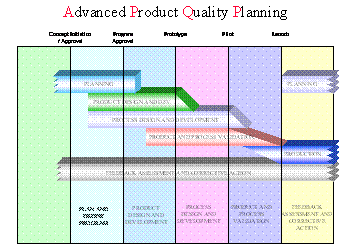|
APQP - Advanced Product Quality Planning - What is it?
Advanced Product Quality Planning (APQP) is a structured methodology
of defining and establishing a productivity and quality framework necessary to assure
that the development of products in industry satisfies the customer, particularly
in the automotive industry. Its purpose is to produce a product quality plan which
will support development of a product or service that is able to direct resources
to satisfy the customer, promote early identification of required changes, avoid
late changes and provide a quality product right first time at the lowest cost.
An outline of this methodology is shown below:
Historically, APQP was initially developed by Ford, GM and Chrysler in the late
1980's. Suppliers to these companies were/are required to apply the APQP methodology
and show compliance as audited by QS9000; Verband des Automobilindustrie (VDA) which
is the German Management System for the automobile industry or the most recent TS16949
standard. APQP itself is maintained by the Automotive Industry Action Group, AIAG.
APQP Phases
The five APQP phases are logical steps in most businesses and the model can be applied
to a service company although much discretion and interpretation may be involved.
The outputs from one phase are necessarily inputs to the next phase except for phase
5 where there is not output phase.
|
|
 APQP Phase 1:Plan
and Define Program APQP Phase 1:Plan
and Define Program
In phase 1, it is important to determine customer needs, requirements & expectations
using tools such as Kano Analysis, Voice of Customer (VOC) and Quality Function
Deployment (QFD). The entire quality planning process must also be reviewed to enable
the implementation of a quality program as a series of input and output processes.
|
 |
|
|
 APQP Phase 2:Product
Design and Development APQP Phase 2:Product
Design and Development
In phase 2, the outputs from phase 1, now inputs to phase 2, are reviewed and acted
upon to give outputs of phase 2. Actions in phase 2 include Failure Mode Effects
Analysis (FMEA), Design for Manufacturing and Assembly (DFMA), design verification,
design reviews, material and engineering specifications.
|
|
|
 APQP Phase 3:Process
Design and Development APQP Phase 3:Process
Design and Development
In phase 3, the outputs from phase 2, now inputs to phase 3, are used to develop
the manufacturing system and related Control Plans (CP) or Dynamic Control Plans
(DCP) to achieve quality products. The manufacturing system must assure that customer
requirements, needs and expectation are met or exceeded.
|
|
|
 APQP Phase 4:Product
and Process Validation APQP Phase 4:Product
and Process Validation
In phase 4, the outputs from phase 3, now inputs to phase 4, are necessary to validate
the selected manufacturing process and its control mechanisms. The validation process
begins with the production trial run evaluation outlining mandatory production conditions
and requirements identifying the required outputs.
|
|
|
 APQP Phase 5:Feedback,
Assessment and Corrective Action APQP Phase 5:Feedback,
Assessment and Corrective Action
Phase 5 runs in parallel with phases 1 – 4. Here, the emphasis is on reduced
variation and continuous improvement identifying outputs and links to customer expectations.
Its focus is to evaluate the effectiveness of the product quality planning at all
stages.
|
Control Plan Methodology
This methodology explains how Control Plans must be instituted to manage relevant
data for continuous (and breakthrough) improvement of the products and process in
APQP.
The CP is introduced for 3 distinct phases in APQP. These are the Prototype Control
Plan at the end of phase 2, Pilot or Pre-launch Control Plan at the end of phase
3 and the Production Control Plan at the end of phase 4.
The Prototype Control Plan controls (or rather monitors) the dimensional measurements,
material and functional tests that will occur during the prototype build.
The Pre-launch Control Plan monitors the dimensional measurements, material and
functional test that will occur after the prototype is built and before full production.
This plan is normally used until the production process is shown to be statistically
stable and capable.
The Production Control Plan monitors the dimensional measurements, material and
functional tests that will be used to control parts and processes for ongoing full-scale
production. It is a logical extension of the pre-launch control plan. Included in
the appendices are several valuable checklists for determining if all issues are
being addressed for the various functions of the quality planning process, as well
as a good description of various analytical techniques used throughout the five
phases. Also included are forms used in the process, suitable for photocopying,
such as the "Team Feasibility commitment" and "Product Quality Planning
Summary and Sign-Off" forms.
|









